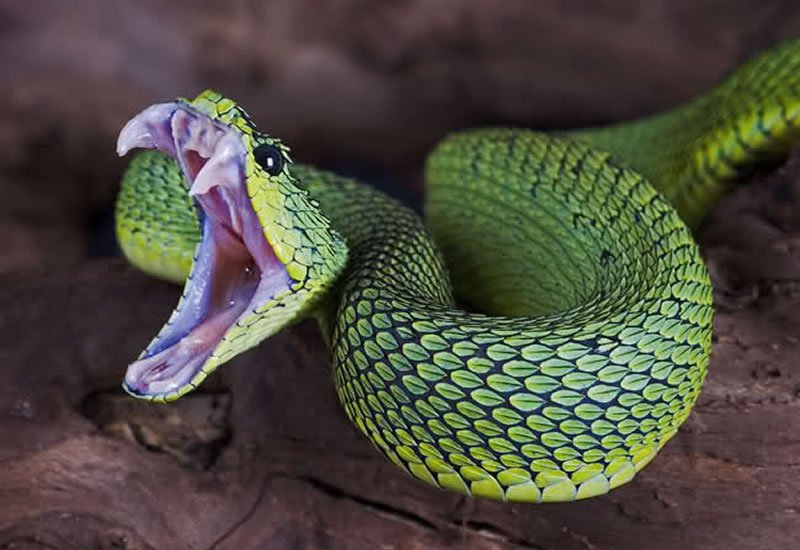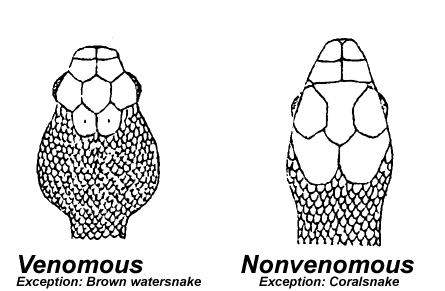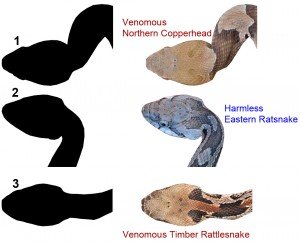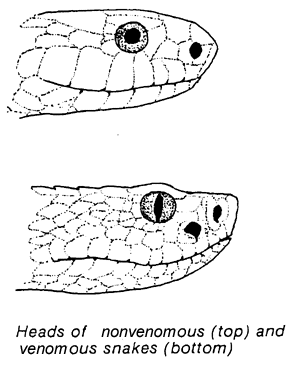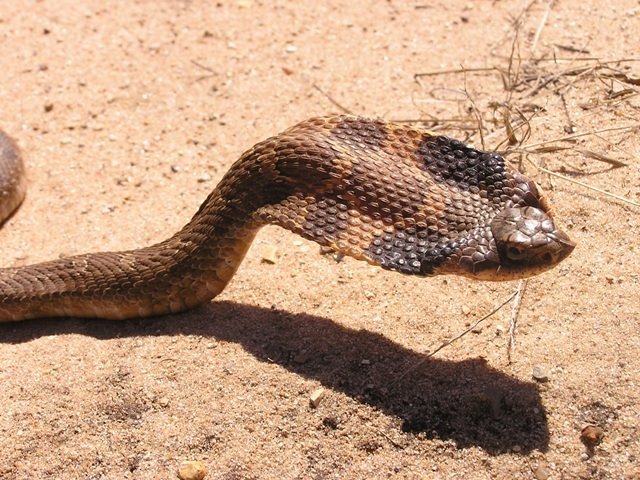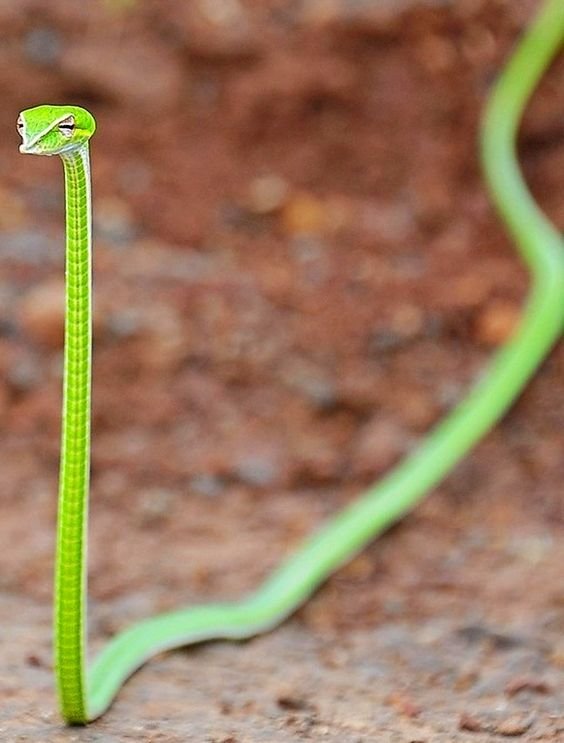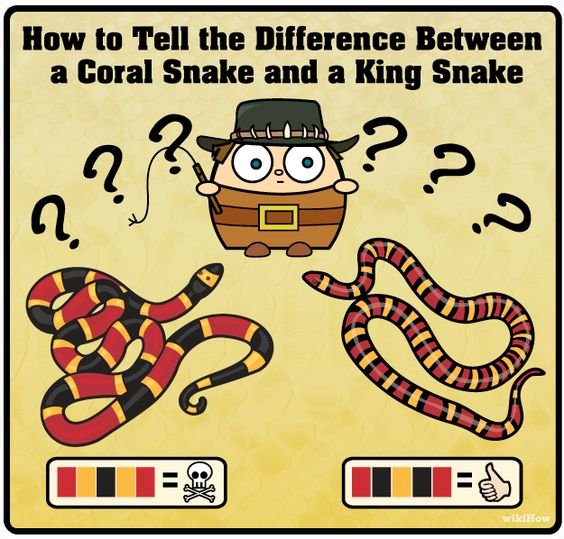It doesn't matter if you absolutely love snakes or are highly afraid of them, at one point or another, you have heard some method of identifying a venomous snake. And for good reason, venomous species can be very dangerous, and knowing how to recognize these species is important! But unfortunately, many of these methods are vague at best, and some are just downright wrong. This leads to people being injured by snakes they didn't realize were harmful, or individuals killing harmless snakes they believed to be deadly. So for the safety of both snakes and my fellow steemians, I want to talk a little bit today about why you can't always trust the common "advice".
Venomous snakes have triangle heads: I believed this to be true for so long. I grew up being told that you could recognize venomous species because their head is triangle shaped, and I still hear parents telling their children this when they visit our facility. It's not necessarily wrong (I can actually rely on this in the field) but there is something many people don't realize: THIS RULE ONLY APPLIES IN CERTAIN REGIONS. Here in Virginia, all our venomous snakes are pit vipers, and they all display the triangle shaped head (the venom glands give them this triangular look). However, once you enter North Carolina, this rule no longer works. In addition to pit vipers, several states are home to the coral snake, a species more related to cobras, that has a rounded head (more on the coral snake later). People have been hospitalized after picking up coral snakes because they assumed they were non-venomous due to the rounded head.
Even in Virginia, where our venomous snakes do have triangular heads, there are situations in which this rule may not apply. Many non-venomous snakes, when threatened, will flatten their head. In the animal kingdom, size is often perceived as power, so many animals, including snakes, will attempt to make themselves look as large as possible. Unfortunately for these snakes, flattening their head gives them the appearance of a venomous species, as seen in the photo below. And some non-venomous species, like pythons, simply have heads that may appear somewhat triangular depending on the person observing them. Head shape is simply not enough to determine venomous from non-venomous.
Venomous snakes have slit pupils: First off, PLEASE don't try to identify snakes using this rule! If you are close enough to make out a snake's pupils, you are waaay too close, especially because this rule does not always apply! Just like the triangular head, slit pupils generally only seen in pit vipers, such as rattlesnakes and copperheads. Other venomous species like elapids (the cobra family) have round pupils like non-venomous snakes do. Again, the coral snake would be the local(ish) exception to the rule; its round eyes lead many observers to believe it is a non-venomous animal (fortunately, the coral snake is the only venomous species in the US that is NOT a pit viper).
If it shakes its tail, it is venomous: Not quite true, but can be rephrased; "If it has a rattle on its tail, it is venomous". Only rattlesnakes carry the iconic structure and all rattlesnakes are venomous pit vipers. But the action of shaking the tail is not unique to these snakes. In fact, just about all snakes (venomous and non-venomous) will shake their tail when disturbed, as a warning again predators. The sound of their scales vibrating against one another can make a buzzing sound very reminiscent of a rattlesnake. Many young snakes, incapable of adequately defending themselves, will employ this tactic to startle predators, and make a hasty getaway. Of course, if a snake DOESN'T have a rattle, it can still be venomous; other species of pit vipers and cobras are quite venomous and lack a rattle (many rattlesnakes are now being born without a rattle. Thanks to events like the annual rattlesnake round up, more and more rattle-less snakes are reproducing. This is because people capture and kill the rattlesnakes they hear rattling, and those without the rattle go undetected!).
All "hooding" snakes are venomous: We've seen the action movies where the hero is confronted by a dangerous cobra, who spreads its magnificent hood before striking. Like head-flattening, the hood is actually used by snakes to make themselves look bigger and more intimidating to predators (this is why most cobras have spots that look like eyes on their hood). The hood is made by these snakes spreading their ribs just below their head. Many non-venomous species can employ the same tactic to appear larger; the local hognose snake (pictured below) is quite harmless, but will spread its head and neck out, making it look like a small cobra to the average person!
Snakes with diamond patterns are venomous: Unless you are extremely familiar with local snakes and recognize the patterns of individual species, NEVER just assume a species is venomous or non-venomous based on its colors/patterns. All snakes come in a variety of tones, colors and patterns, some used to blend into their surroundings while others are made to stand out, warning predators of danger. Many non-venomous snakes will also mimic venomous species, leading predators to leave them alone. Dull, brown snakes with checkered or diamond patterns are often mistaken as venomous, however this is a really common appearance among snake world-wide.
Fat snakes are venomous, skinny snakes are harmless: Pit vipers are short and stout snakes and can be identified by their larger bodies. But again, species like the cobras are relatively long and thin, and would be misidentified following this rule (another reason people have dangerous encounters with coral snakes in the US). And while most non-venomous species are typically long and thin, some are a bit heftier, built for a life on the ground or burrowing (like the hognose snake pictured above). The rule can also be difficult because of snakes' ability to puff themselves up to, you guessed it, make themselves appear larger and more formidable. And some constrictors, like boas and pythons, are incredibly thick, heavy bodied snakes that may look even thicker after a large meal.
Snakes that are yellow, black and red are venomous: You knew this was coming: the coral snake. This guy lives just to defy our identifications of venomous snakes. They are easily recognized and stand out thanks to their vibrant colors; colors that say, "stay away, I'm deadly!". So why do people pick them up? Because they mistake them for harmless species like milk snakes and scarlet king snakes. These non-venomous species are mimics, and benefit by resembling the venomous coral snake. Most predators recognize the fierce colors of the coral snake, and leave the mimics alone. Just remember, as long as the red band are touching black, there is no danger, but when red bands touch yellow, you're dealing with a venomous coral snake (you all know the rhymes!).
So how do we recognize venomous snakes then? Unfortunately, there is no set rule that we can use to identify venomous/non-venomous. While there are tricks to identifying elapids and pit-vipers from non-venomous species, it seems that there is always at least one exception to the rule or odd situation in which the rule doesn't apply. So what should you do when confronted with an unidentified snake?
LEAVE IT ALONE.
More than likely, it is non-venomous, but why take the risk if you don't know what it is? Even non-venomous snakes, like ANY other wild animal, will defend themselves when they feel threatened (wouldn't you?). If it is venomous, giving them their space will keep both of you safe. Take photos or notes and try to identify the species you encountered. It's always a good idea to familiarize with the species around your home (in general, I think it's highly beneficial to at least be aware of what lives in your own backyard). A little knowledge can go a long way in keeping you, and native wildlife, safe!

